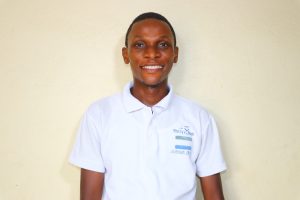The 120 community members in the Bakolo Junction Community struggle to access sufficient, safe water. They have a dug well that is overcrowded and unreliable during the drought season. When collecting water from the well is impossible or too time-consuming, people must use the local swamp that provides contaminated water.

Field Officer Julius Sesay shared, "The well they rely on is located at the upper part of the community. All the other existing houses find it hard to fetch water from this source, looking at the distance. Apart from this, they are faced with the constraints of overcrowding because of the demand for water from community members. This pressure often makes the waterpoint easily break down. Similarly, the waterpoint is seasonal and not pure to drink. The water users complain that water changes in color, making them unable to use it for drinking. This alone makes them suffer."

The distant, unreliable well.
Julius continued, "The swamp, their other source of fetching water, is a distance away from them. This source also has similar characteristics to the main waterpoint. The water easily becomes dirty, and [it has] a salty taste. It makes it difficult for one to use it to drink. There are times when the color of the water even changes. One cannot even launder with the water, let alone use it to cook. This is really a problem for them."

The swamp.
15-year-old Adamsay is familiar with the hardships associated with her community's water crisis.
"I see it as a burden whenever I am asked to fetch water. I must walk all the way down to the swamp to fetch water. It is not easy for me. The distance is far, and at times, the water from the swamp becomes less in quantity. Even to fetch a full gallon of water will be difficult," she shared when asked how she feels.

Adamsay at the swamp.
Adamsay spends time collecting or attempting to collect in the dry season, which could be spent in the classroom. Living in a culture where girls have a more challenging time getting an education, adding a water crisis into the mix creates an even more significant hurdle to overcome.
Not only is their education suffering, but children like Adamsay also feel the effects on their health.
Field Officer Julius said, "Due to [the] long walking distance, some of the children that do not use "kata" will end up having sores in the middle of their head. This even makes them have bald headaches. Since no hair will be in the middle of their head. When we say kata, it means a cloth that children will fold and place on their heads before putting the rubber bucket or jerry can on top of it. The weight of the bucket and walking distance make it unbearable for them."

Adamsay carrying water back home.
"Studies have also shown a connection between the time and distance a person travels to a water source and the health of family members within their household. Even just a 15-minute decrease in traveling time to a water source causes a 41% average reduction in diarrhea prevalence, improved child nutrition, and an 11% reduction in deaths for children under five," says Jamie Heminway, TWP copywriter.
Installing a new well closer to Adamsay will eliminate many of her worries. A borehole well is unlikely to run dry in the dry season and will produce safe water. She will no longer have to spend all her time traveling to and from distant, unsafe waterpoints, but instead can go to school and pursue her dreams!
Steps Toward a Solution
Our technical experts worked with the local community to identify the most effective solution to their water crisis. They decided to drill a borehole well, construct a platform for the well, and attach a hand pump.
Well
Abundant water often lies just beneath our feet. Aquifers—natural underground rivers—flow through layers of sediment and rock, offering a constant supply of safe water. A borehole well is drilled deep into the earth to access this naturally filtered and protected water. We penetrate meters, sometimes even hundreds of meters, of soil, silt, rock, and more to reach the water underground. Once found, we construct a platform for the well and attach a hand pump. The community gains a safe, enclosed water source capable of providing approximately five gallons of water per minute. Learn more here!
Community Education & Ownership
Hygiene and sanitation training are integral to our water projects. Trainingcommunity'sd to each community's specific needs and includes key topics such as proper water handling, improved hygiene practices, disease transmission prevention, and care of the new water point. Safe water and improved hygiene habits foster a healthier future for everyone in the community. Encouraged and supported by the guidance of our team, a water user committee rcommunity'sve of the community's diverse members assumes responsibility for maintaining the water point, often gathering fees to ensure its upkeep.

 Borehole Well and Hand Pump
Borehole Well and Hand Pump
 Rehabilitation Project
Rehabilitation Project
















